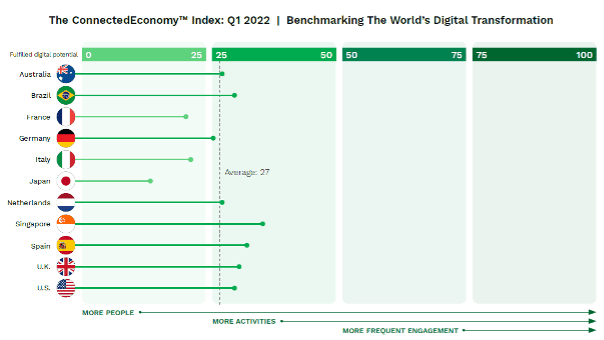Digital Engagement of Spain, UK Gen Z Consumers Highest Of All Age Groups

European countries like France and Italy are what economists refer to as “mature markets.”
Populations in these countries typically have a high level of smartphone ownership and benefit from good broadband coverage as a result of the region’s technological progress and development.
Against that backdrop, one is likely to expect European Union countries to top any index on digital transformation. And yet, a PYMNTS study of 15,100 individuals across 11 countries paints a far more complex picture.
Get the report: Benchmarking the World’s Digital Transformation
In this series, PYMNTS will draw insights from the “Benchmarking the World’s Digital Transformation” report, published in collaboration with Stripe, to probe into the way people in each of the five EU countries studied — Germany, Spain, France, Italy and the Netherlands — use and are impacted by digital technologies.
Spain Leads EU-5 in CE Index Ranking
PYMNTS ConnectedEconomy™ Index (CE Index) is an objective metric that reveals the extent of digital transformation in countries and their economies.
Of the five EU countries included in the report, excluding the United Kingdom, Spain performed best in the CE Index ranking, with a score of 32 out of a possible 100. In the country, 93.2% of the population are connected to the internet and 87% own a smartphone.
Read more: PayPal Leading Digital Wallet in EU-5, Ahead of Cards in Germany, Study Finds
New 11-Country Study Shows Digital Transformation Has Reached Only 27% of Full Potential
As part of the CE Index methodology, PYMNTS also measured how much people engaged with 40 different activities used to define digital transformation.
The study found that apart from the 6.8% of Spanish survey respondents who don’t have access to a regular internet connection, the remaining sample members either had a low (34%), medium (37.6%), or high (21.6%) level of overall digital engagement.
Compared to the other 11 countries the report covered, the picture of different engagement levels in Spain demonstrates a moderate engagement curve. In other words, engagement levels do not drastically diverge between heavy and light use of digital technologies, with no single group representing more than half of the surveyed population.

As well as varying use levels, the CE Index further showed how use differs from generation to generation.
In Spain, the generational breakdown of the CE Index revealed a decline in engagement with each older generation. Generation Z respondents (18 to 25 years) in the country had an average score of 46, millennials (26 to 41 years) an average of 42, bridge millennials (34 to 43 years) an average 39, Generation X (42 to 57 years) 32, and a baby boomers and seniors (58 years and older) 21.
The CE Index score of 46 observed among Gen Z respondents in Spain — the same as for U.K.’s Gen Zers — was highest of any group surveyed across all countries.
The report further revealed that Spain had a flat engagement distribution across generations compared to the other EU countries. Unlike other EU countries where engagement dropped off among older populations, the relatively high CE Index score observed among older Spanish citizens contributed to the country’s higher overall ranking compared to its European neighbors.
Spain is the only EU country in which all generations, excluding the oldest group, scored over 30. The presence of high levels of digital engagement even among Gen X is noteworthy when considering the global picture. Only Singapore joined Spain in having such a high level of engagement among Gen X respondents.
Sign up here for daily updates on all of PYMNTS’ Europe, Middle East and Africa (EMEA) coverage.